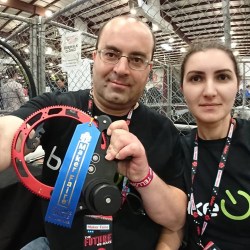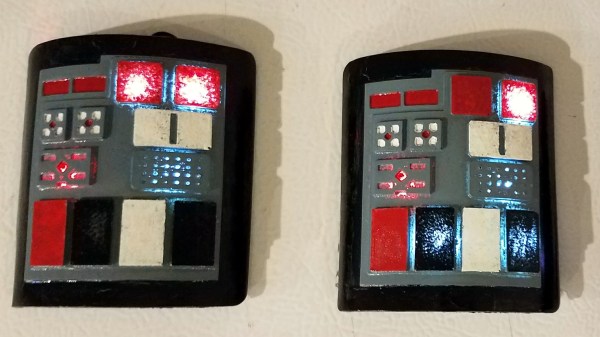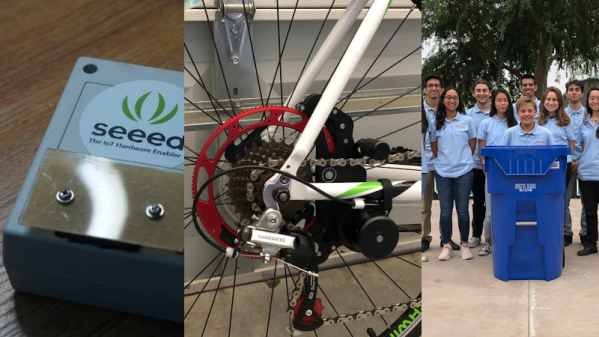So you say you missed the Great Solar Storm of 2024 along with its attendant aurora? We feel you on that; the light pollution here was too much for decent viewing, and it had been too long a day to make a drive into the deep dark of the countryside survivable. But fear not — the sunspot that raised all the ruckus back at the beginning of May has survived the trip across the far side of the sun and will reappear in early June, mostly intact and ready for business. At least sunspot AR3664 seems like it’s still a force to be reckoned with, having cooked off an X-class flare last Tuesday just as it was coming around from the other side of the Sun. Whether 3664 will be able to stir up another G5 geomagnetic storm remains to be seen, but since it fired off an X-12 flare while it was around the backside, you never know. Your best bet to stay informed in these trying times is the indispensable Dr. Tamitha Skov.
marketing18 Articles
AI And Savvy Marketing Create Dubious Moon Photos
Taking a high-resolution photo of the moon is a surprisingly difficult task. Not only is a long enough lens required, but the camera typically needs to be mounted on a tracking system of some kind, as the moon moves too fast for the long exposure times needed. That’s why plenty were skeptical of Samsung’s claims that their latest smart phone cameras could actually photograph this celestial body with any degree of detail. It turns out that this skepticism might be warranted.
Samsung’s marketing department is claiming that this phone is using artificial intelligence to improve photos, which should quickly raise a red flag for anyone technically minded. [ibreakphotos] wanted to put this to the test rather than speculate, so a high-resolution image of the moon was modified in such a way that most of the fine detail of the image was lost. Displaying this image on a monitor, standing across the room, and using the smartphone in question reveals details in the image that can’t possibly be there.
The image that accompanies this post shows the two images side-by-side for those skeptical of these claims, but from what we can tell it looks like this is essentially an AI system copy-pasting the moon into images it thinks are of the moon itself. The AI also seems to need something more moon-like than a ping pong ball to trigger the detail overlay too, as other tests appear to debunk a more simplified overlay theory. It seems like using this system, though, is doing about the same thing that this AI camera does to take pictures of various common objects.
Social Engineering And Menus
If you follow cybersecurity hacker methods — or just watch Mr. Robot — you probably know that the best way to get someone’s password is to ask for it. Sure, you probably can’t just say “Hi, I’m a bad guy. Can I have your password?” But there are all sorts of tricks you can use like pretending to be in the person’s IT department, someone in management, or by making up a crisis to overcome their better judgement with a sense. But of course, as wise computer people, we are immune to such things, right? We also don’t need those kinds of tricks in our arsenal.
Is that true? It is amazing how many subtle things influence what we think are rational decisions, no matter who we are. Consider going to eat in a restaurant. Simple, right? You look at the menu, pick what you want, and order. No one is influencing you. But they are. According to a BBC article, there’s a whole industry of menu “engineering” that figures out how to get you to order pricey food.
You might not think social engineering for menus is a great skill for us. But maybe your new open source project needs collaborators. Maybe your startup company needs investors. Maybe you’d like someone to look at your resume. Maybe the same tricks that work with diners will work in those cases, too.
Tips From A Former Niche Item Etsy Store
Etsy is a service aimed at providing a way for makers of handmade items to sell them online. [Bithead] closed up shop earlier this year and wrote up an interesting perspective on what did and didn’t work out. The main market for [Bithead]’s store was Star Wars cosplayers, because it all started with some Star Wars inspired com pads, some of which are pictured here.
 One thing [Bithead] felt worked well overall was to “think big, start small, and scale fast.” In essence, bootstrap things by selling inventory on hand and carefully monitoring demand, then if demand is sustained, ramp up to larger batches, which are more efficient. The risk of making larger part orders and carrying more stock on hand is offset by the reliable demand. Waiting until solid data on reliable demand is available means missing out on early sales, but it’s a low risk approach that works well for niche products that have little or no real competition.
One thing [Bithead] felt worked well overall was to “think big, start small, and scale fast.” In essence, bootstrap things by selling inventory on hand and carefully monitoring demand, then if demand is sustained, ramp up to larger batches, which are more efficient. The risk of making larger part orders and carrying more stock on hand is offset by the reliable demand. Waiting until solid data on reliable demand is available means missing out on early sales, but it’s a low risk approach that works well for niche products that have little or no real competition.
A couple things that didn’t work out were efforts to follow Etsy’s advice to add more products to attract a wider audience, and to try out tools for offering discounts and incentives aimed at turning abandoned carts into sales. Neither went well. The first resulted in adding items that sold poorly, diluted the focus of the store, and incurred a cost for each listing. The second never seemed to have any impact on sales whatsoever. Perhaps there is a place for these efforts, but [Bithead]’s niche market wasn’t it.
It’s a good read about how things went for an Etsy store that served a niche audience over three years. The perspective and experiences might be useful to anyone looking to turn a bright idea into something sold online, so if you’re at all interested, take a few minutes to check it out.
We’ve seen [Bithead]’s work before, this lightsaber-inspired violin bow was one project that went on to become a kit for sale.
Linux’s Marketing Problem
The cult classic movie Office Space is a scathing critique of life for software engineers in a cubicle farm, and it did get a lot of things right even if it didn’t always mean to. One of those is the character of Tom Smykowski whose job is to “deal with the customers so the engineers don’t have to”. The movie treats Tom and his job as a punchline in a way, but his role is actually very important for most real businesses that rely on engineers or programmers for their core products.
Engineers can have difficulty relating to customers, and often don’t have the time (or even willingness) to handle the logistics of interacting with them in the first place. Customers may get frustrated understanding engineers or communicating their ideas clearly to them. A person like Tom Smykowski is often necessary to bridge the gap and smooth out the rough edges on both sides, but in the Linux world there are very few Toms to rely on. The customers, or users, have to deal directly with the engineers in many situations, and it’s not working out very well for either group. Linux has a marketing problem, and it needs a marketing solution if it ever wants to increase its market share in the PC realm. Continue reading “Linux’s Marketing Problem”
Kickstarter Hack Chat
Join us on Wednesday, August 7th at noon Pacific for the Kickstarter Hack Chat with Beau Ambur and Clarissa Redwine!
For many of us, magic things happen on our benches. We mix a little of this, one of those, and a couple of the other things, and suddenly the world has the Next Big Thing. Or does it? Will it ever see the light of day? Will you ever build a community around your project so that the magic can escape the shop and survive the harsh light of the marketplace? And perhaps most importantly, will you be able to afford to bring your project to market?
Crowdfunding is often the answer to these questions and more, and Kickstarter is one of the places where hackers can turn their project into a product. Beau and Clarissa, both outreach leads for the crowdfunding company, will stop by the Hack Chat to answer all your questions about getting your project off the bench and into the marketplace. Join us as we discuss everything from building a community that’s passionate enough about your idea to fund it, to the right way to share your design story.
 Our Hack Chats are live community events in the Hackaday.io Hack Chat group messaging. This week we’ll be sitting down on Wednesday, August 7 at 12:00 PM Pacific time. If time zones have got you down, we have a handy time zone converter.
Our Hack Chats are live community events in the Hackaday.io Hack Chat group messaging. This week we’ll be sitting down on Wednesday, August 7 at 12:00 PM Pacific time. If time zones have got you down, we have a handy time zone converter.
Click that speech bubble to the right, and you’ll be taken directly to the Hack Chat group on Hackaday.io. You don’t have to wait until Wednesday; join whenever you want and you can see what the community is talking about.
Hackaday Prize Mentor Session: Beau Ambur
Beau Ambur can often be found hosting hardware events and offering help all around the Bay Area. Now he’s turned it into a career and travels the west coast helping hackers and creators effectively leverage Kickstarter’s platform. Beau’s mentor session covers everything from, “is this project a good fit for venture capital?” to, “is open source a good fit for my project?”.
For this year’s Hackaday Prize we’ve found experts in a wide range of fields so you can take your entries to the next level regardless of the stage the project is in. The sessions are on a first come basis so sign up now for a chance to get some valuable feedback on your entry.
Your Robot Language Coach
 The first project is a Personal English Trainer by the lonely programmer. As a student he noticed a need for a more interactive and portable language learning aid. Solutions do exist on the market but they are along the lines of a pocket dictionary, instructional phone app, or a full on translator. These break the flow of thought and conversation. The lonely programmer envisioned something that you can conversationally ask for help as you’re using a new language.
The first project is a Personal English Trainer by the lonely programmer. As a student he noticed a need for a more interactive and portable language learning aid. Solutions do exist on the market but they are along the lines of a pocket dictionary, instructional phone app, or a full on translator. These break the flow of thought and conversation. The lonely programmer envisioned something that you can conversationally ask for help as you’re using a new language.
As many have discovered, the best way to see if there’s a need for something is to build a minimum viable product (MVP). The snips.ai platform offered the perfect foundation to quickly test out the idea. It’s working on a few words and he wants to get it ready for more people to play with the idea. The majority of the lonely programmer’s questions centered around making the project interesting for other hackers so that it could one day turn into a product.
Bolt-On Bike Assist
 Rob and Shushanik are developing a project called BikeOn. It bolts to any bicycle and converts it to an electric assist bike without tools or replacing any components. BikeOn has already won some accolades such as Editors Choice at the last 2019 Makerfaire Bay Area. Rob had a few questions on how to transition a project from the proof of concept stage to the product stage. The discussion went over using open source as a tool for product promotion as well as getting funding for taking a hardware product to market.
Rob and Shushanik are developing a project called BikeOn. It bolts to any bicycle and converts it to an electric assist bike without tools or replacing any components. BikeOn has already won some accolades such as Editors Choice at the last 2019 Makerfaire Bay Area. Rob had a few questions on how to transition a project from the proof of concept stage to the product stage. The discussion went over using open source as a tool for product promotion as well as getting funding for taking a hardware product to market.
He also wanted to know if there was anything the team could do to have a better shot at winning the prize. There were a few good tips such as directly focusing on the five categories the judges would be looking at: Concept, Design, Production, Benchmark, and Communication. It is also important to cover the development journey. Why did you make the choices you made when designing the project?
No-Spill Trash Can Concept
 Rounding out this mentor session, Jeannie and her team of highschool students demonstrate SEAL. In the area around the Granada Hills Charter High School there are winds mighty enough to blow over full trashcans. This trash travels to the ocean and disrupts local ecosystems. The team is working on a device which can detect a tipping trashcan and keep the lid from opening.
Rounding out this mentor session, Jeannie and her team of highschool students demonstrate SEAL. In the area around the Granada Hills Charter High School there are winds mighty enough to blow over full trashcans. This trash travels to the ocean and disrupts local ecosystems. The team is working on a device which can detect a tipping trashcan and keep the lid from opening.
Prototyping started with Arduinos, but they’ve already escalated to designing their own PCBs. Their hope is to produce a run of fifty devices and try them out with a local commercial partner. Beau recommended they look into the Micropython ecosystem. Not only would the students get the advantage of using the STM32 chips in their board layouts (reducing the number of support components they would need), micropython would make it easier for students to jump in and help rather than having to learn the nuances of C first.
The Hackaday Prize mentoring sessions continue through the summer so don’t forget to sign up and check out the list of mentors who are here to share their knowledge and experience.
Continue reading “Hackaday Prize Mentor Session: Beau Ambur”


















